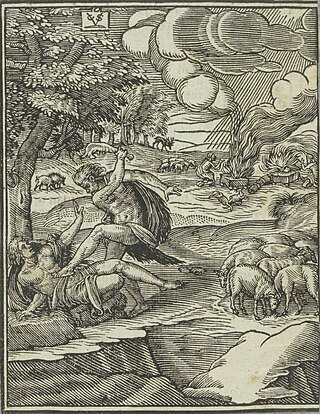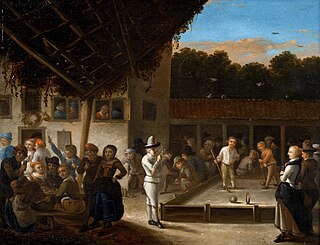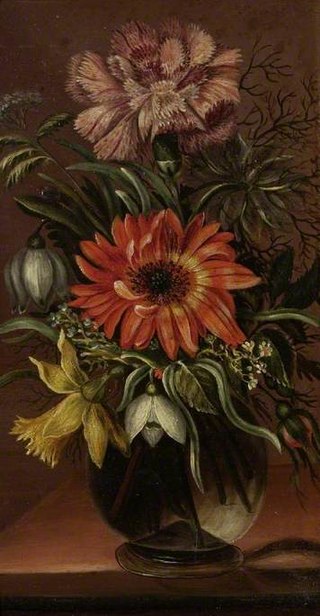
Abraham van den Hecken or Abraham van den Hecken the Younger (Antwerp, 1616 - between 1655 and 1669) [1] was a Dutch-Flemish painter. He is known for his genre pieces, religious and historical scenes, portraits and still lifes. [2]

Abraham van den Hecken or Abraham van den Hecken the Younger (Antwerp, 1616 - between 1655 and 1669) [1] was a Dutch-Flemish painter. He is known for his genre pieces, religious and historical scenes, portraits and still lifes. [2]
Little is known about the life of Van den Hecken. Both his birth and death dates are uncertain. There is also some confusion with the life and work of another artist called Abraham van den Hecken the Elder who was a copperplate engraver, goldsmith and silversmith active in Frankenthal and Amsterdam. [3] His relationship with this Abraham van den Hecken the Elder is not clear. Abraham van den Hecken the Elder was a member of a family of Flemish immigrants who moved from Antwerp to Frankenthal in Germany where they were active as goldsmiths. As Abraham van den Hecken the Elder collaborated on some prints with the printmaker and publisher Christoffel van Sichem the Elder and Christoffel van Sichem the Younger, the son of Christoffel van Sichem the Elder, was later the best man at Abraham van den Hecken the Younger's wedding, a family relationship seems likely. [4]

Abraham van den Hecken the Younger was born in Antwerp where he was baptized on 23 March 1616 as the son of Samuel van den Hecken and Sara Geijluwe. [1] His father was a landscape and still life painter. His father moved in the 1620s to the Dutch Republic and was probably his first master. His sister Magdalena became a still life painter. [2]
He posted banns of marriage on 7 July 1635 in Amsterdam for his marriage to Catharina Lundens, a sister of Gerrit Lundens. The couple got married on 29 July 1635 in Sloterdijk, with Christoffel van Sichem the Younger, an uncle of Lundens, acting as Abraham's best man. [2] Gerrit Lundens was possibly a pupil of van den Hecken. [2]

From 1647 to 1649 van den Hecken was active in The Hague. He returned to Amsterdam in 1649. In 1652 he traveled to London where he was deacon of the Dutch Church. [2]
He returned to The Hague in 1653. He died after 22 January 1655 and before 1669, when his wife was recorded as a widow. The place of death is believed to be Amsterdam or The Hague. [2]
He painted genre scenes, history painting, portraits, Christian religious scenes, fruit still lifes and flower still lifes. [2]

Jan Davidsz. de Heem or in-full Jan Davidszoon de Heem, also called Johannes de Heem or Johannes van Antwerpen or Jan Davidsz de Hem, was a still life painter who was active in Utrecht and Antwerp. He is a major representative of that genre in both Dutch and Flemish Baroque painting.
Events from the year 1615 in art.

Flemish Baroque painting was a style of painting in the Southern Netherlands during Spanish control in the 16th and 17th centuries. The period roughly begins when the Dutch Republic was split from the Habsburg Spain regions to the south with the Spanish recapturing of Antwerp in 1585 and goes until about 1700, when Spanish Habsburg authority ended with the death of King Charles II. Antwerp, home to the prominent artists Peter Paul Rubens, Anthony van Dyck, and Jacob Jordaens, was the artistic nexus, while other notable cities include Brussels and Ghent.

Frans Francken the Younger was a Flemish painter and the best-known and most prolific member of the large Francken family of artists. He painted large altarpieces for churches as well as smaller historical, mythological and allegorical scenes. His depictions of collectors' cabinets established a popular new genre of art in the era. Francken often collaborated with other artists, adding figures and narrative elements to scenes created by specialists in landscape, architectural and floral still life paintings.

The Haarlem Guild of Saint Luke was first a Christian, and later a city Guild for various trades falling under the patron saints Luke the Evangelist and Saint Eligius.

Abraham de Vries was a Dutch painter who was one of the leading portraitists of his age. As he led a peripatetic lifestyle and worked in France, Antwerp and the Dutch Republic his stylistic qualities are difficult to pin down.
Roger de Piles's L'Abrégé de la vie des peintres...avec un traité du peintre parfait was a major art biography of painters. It was written by the French spy Roger de Piles. In 1692, during the War of the League of Augsburg, he was arrested in the Hague carrying a false passport and imprisoned for the next five years, where he wote his L'Abrégé in 7 parts; 1) Sketch of the perfect painter, 2) Greek painters; 3) Painters from Rome & Florence; 4) Painters from Venice; 5) Painters from Lombardy; 6) Painters from Germany and the Low Countries; 7) Painters from France and ending with his famous "Balance of painters". The book was finally published in 1699 following his appointment as Conseiller Honoraire to the Académie de peinture et de sculpture in Paris.

Christoffel van Sichem or Christoffel van Sichem the Younger(1581, Basel – 1658, Amsterdam), was a Dutch woodcutter, engraver and publisher. He was mainly active as a reproductive artist making prints after the prints or paintings of other artists.

Gerrit Lundens, was a Dutch painter known for his genre scenes, portraits and a single vanitas painting. He also made copies after prominent masters, including Rembrandt. He further operated an inn and was active as a wine merchant.

Jan van Kessel or the other Jan van Kessel was a Flemish painter of still lifes of fruits, hunting pieces and flowers. After training in Antwerp he moved to the Dutch Republic where he is recorded as operating a studio in Amsterdam.

Magdalena van den Hecken was a Dutch Golden Age flower painter from the Northern Netherlands.

Abraham Vinck or Abraham Willemsz. Vinck was a Flemish painter and art dealer who spent most of his life and career outside of Flanders, including in Hamburg, Naples and Amsterdam. He is mainly known as a portrait painter but also practised in many other genres including history painting, mythological scenes, fruit and fish still lifes and market scenes. He was also a copyist who created copies after the great masters. He is now mainly known for being the co-owner together with his Flemish colleague and business partner Louis Finson of two paintings by Caravaggio.
Christoffel Puytlinck, was a painter from Roermond. He painted still lifes, chiefly game pieces and live and dead fowl.